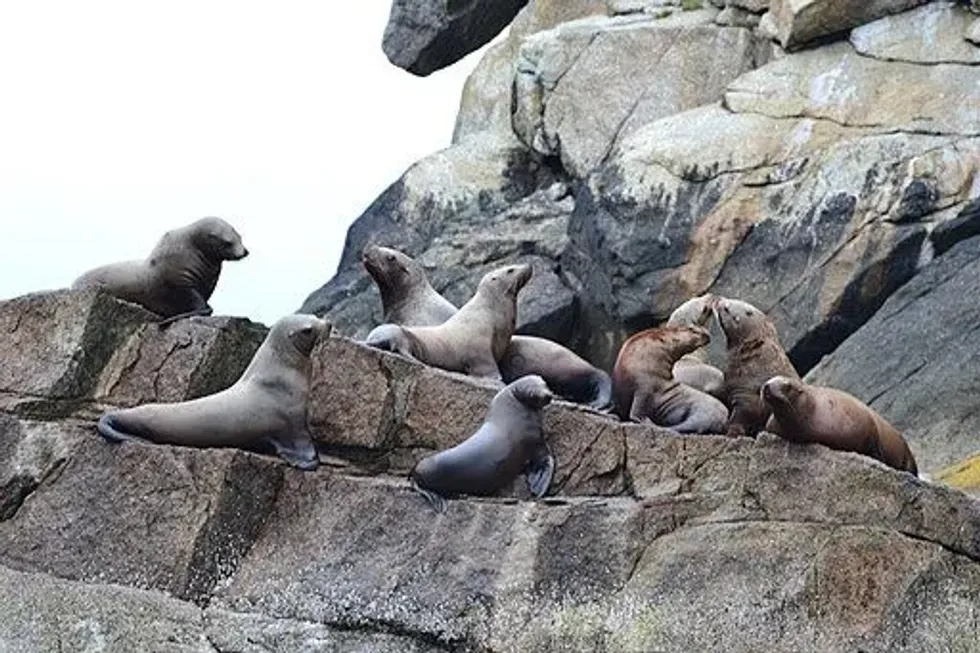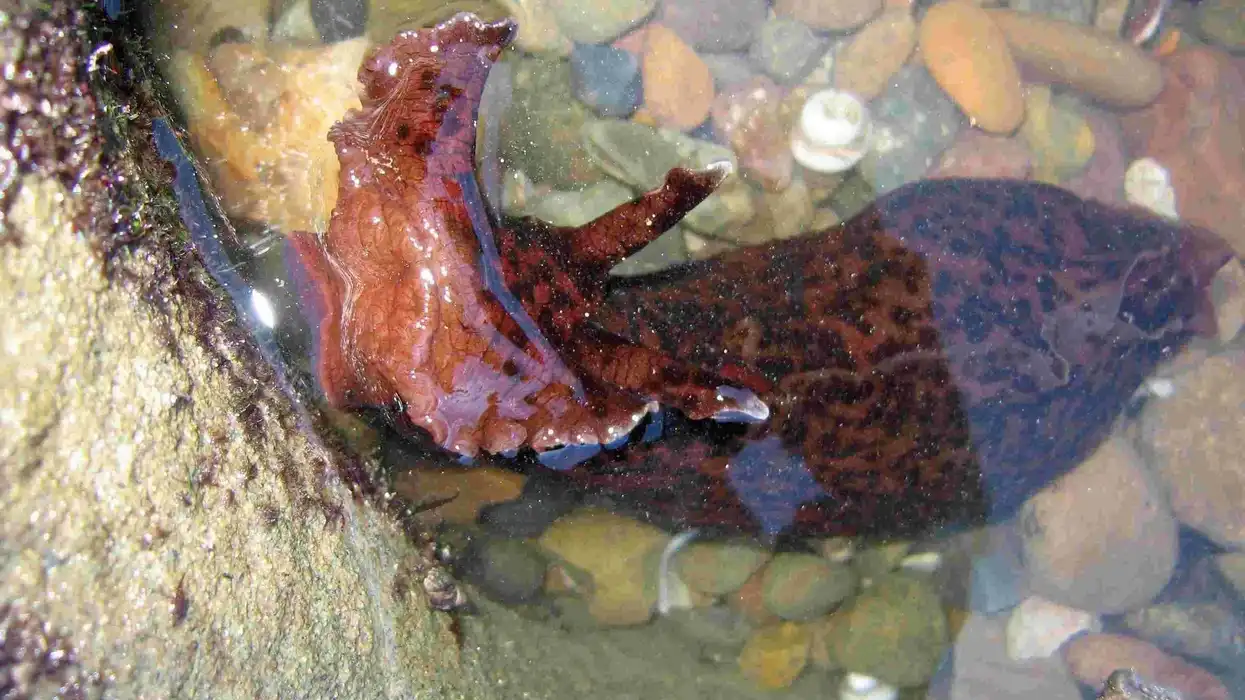The Steller sea lion belongs to the family Otariidae and the Steller sea lion's scientific name is Eumetopias jubatus. Steller sea lions (Eumetopias jubatus) are found in the range that includes Kuril islands in the Sea of Okhotsk in Russia, the Gulf of Alaska, and the central part of California.
Vagrants have been observed in the Bohai Gulf, the Yellow Sea, China, and Korea. The Steller sea lion's habitat consists of subarctic coastal waters.
The breeding or reproduction of these animals takes place in well-defined rookeries. These rookeries are isolated islands and beaches. Breeding takes place once a year and the reproduction is known to be polygynous.
The male Steller sea lion defends its territory and pregnant female Steller sea lions give birth to their pups soon after arriving at the rookeries. Copulation takes place one or two weeks after the females give birth to the pups.
The gestation period is known to be around 274 days long. The weaning age is known to be variable and pups can be with their mothers or females for about four years.
The male is known to be larger than the female Steller sea lion. The color of these Steller sea lions is blonde to reddish-brown but the chest and stomach are known to be darker in color.
Pups are known to be born, more or less, black in color. Male Steller sea lions have broader chests and foreheads as compared to female Steller sea lions. The males are also known to have flatter snouts compared to females.
This marine mammal population prey on herrings, rockfish, flatfish, octopuses, and squids, and also the pups of sea otters. The population of this marine mammal is known to be Near Threatened.
It is really interesting to learn about these marine animals and if you are find these facts fascinating, read our articles about the harbor seal and takin.
Steller Sea Lion Interesting Facts
What type of animal is a Steller sea lion?
A Steller sea lion (Eumetopias jubatus) is a sea lion.
What class of animal does a Steller sea lion belong to?
It belongs to the class of Mammalia.
How many Steller sea lions are there in the world?
There has been no exact number recorded of the recent population of these sea lions.
Where does a Steller sea lion live?
The population of this sea lion is distributed in the range that includes the Kuril islands in the Sea of Okhotsk in Russia, the Gulf of Alaska, and the central region of California. Vagrants have been observed in the Bohai Gulf, the Yellow Sea, China, and Korea.
It is believed that around 70% of the population is found in Alaska.
What is a Steller sea lion's habitat?
The Steller sea lions population tends to inhabit subarctic coastal waters due to the chilly but moderate climate of the region. Steller sea lions are known to spend time both on land and water. They go into the water to eat and come onto the land to mate, raise young ones, molt, and rest.
Who do Steller sea lions live with?
The Steller sea lion population is known to be a social species and can be often spotted in large groups or colonies in their range.
How long does a Steller sea lion live?
The Steller sea lion lifespan is known to be 20 years and the females of this species are known to live for 30 years.
How do they reproduce?
In traditional, well-defined rookeries such as isolated islands and beaches, sexually mature males gather in the mid-spring for breeding. Breeding takes place once a year in the summer months.
The larger and older males are known to establish their territories and almost a week later, females are known to arrive to give birth and breeding. The reproduction system of these Steller sea lions is polygynous.
The females that are pregnant are known to give birth once they arrive at the rookeries and breeding is known to take place one or two weeks post-birth. The egg is not implanted until fall and this fertilized egg remains in the embryonic diapause until around three months.
The gestation period is known to be around 274 days long. The weaning age for this population is known to be variable and pups can be with their mothers or females for about four years.
What is their conservation status?
This species, that is, the Steller sea lion is placed under the Near Threatened category of the conservation status.
Steller Sea Lion Fun Facts
What do Steller sea lions look like?
Sexual dimorphism exists in this sea lion population and thus, males tend to be larger than females, and males are also known to have a thick mane of coarse hair. The color of these Steller sea lions is blonde to reddish-brown but the chest and stomach are known to be darker in color.
Males are known to have wider necks and chests.
Other distinguishing features of the males and females include that males are known to have higher and wider foreheads and flat snouts. A Steller sea lion pup is known to be born, more or less, black in color.
How cute are they?
Steller sea lions are not considered cute by people.
How do they communicate?
Steller sea lions are known to produce sounds like roaring to communicate with each other.
How big is a Steller sea lion?
The Steller sea lion size ranges from 7.5-10.7 ft (230-325 cm). The length of the males ranges from 9.3-10.7 ft (282-325 cm) and that of females ranges from 7.5-9.5 ft (230-290 cm). These Steller sea lions are smaller or similarly sized to leopard seals.
How fast can a Steller sea lion run?
The exact speed of Steller sea lions is unknown but they are known to walk slowly as they pull themselves using their front flippers.
How much does a Steller sea lion weigh?
An average Steller sea lion weight ranges from 530-2470 lb (240-1120 kg). The weight of females of this species is known to be around 530-770 lb (240-349 kg) and males of this species weigh around an average of 990-2470 lb (449-1120 kg).
Steller sea lions can be similar in size or larger than walruses and much larger than harbor seals.
What are the male and female names of the species?
Female sea lions are known as cows and the males are referred to as bulls.
What would you call a baby Steller sea lion?
In general, babies of sea lions are known as pups.
What do they eat?
Steller sea lions are known to be marine predators and are considered to be highly opportunistic feeders. The Steller sea lion diet consists of a variety of cephalopod species and fish.
This species's diet includes Atka mackerel, herring, halibut, walleye pollock, flatfish, Pacific cod, capelin, and rockfish. They also feed on some cephalopods species including octopuses and squids.
Occasionally, this species is also known to prey on harbor seals, northern fur seals, and pups of sea otters. These sea lions are known to eat around 6% of their body weight.
Are they dangerous?
Although these sea lions are known to be not violent, if humans get too close to these sea lions, there is a possibility that this species might harm you.
Would they make a good pet?
Not much information is available about whether these sea lions can be kept as pets but it is believed that these sea lions will not make great pets as they are wild animals.
Also, they currently have a status of Near Threatened, so it is best to allow these seals to live in their natural habitat and follow conservation practices.
Did you know...
Steller sea lions are known to be the largest eared seals and also as the fourth largest pinniped population in the world.
Steller sea lions are often confused with California sea lions, which are darker in color and smaller.
As Steller sea lions are known to walk by using support from their front flippers and pulling their legs, which is unlike seals.
These sea lions are social creatures and might sometimes lay on each other when hauling out of the water and on rocks and logs where they spend a lot of time.
Steller sea lions can be distinguished by their different roars from the bark of California sea lions.
Steller sea lion predators include killer whales and sharks. They are also known to feed on pups of these animals too.
Fishing of the population of fish like herring and flatfish by fisheries or commercial fisheries is quite common, but it leads to less prey for this sea lion.
Are Steller sea lions endangered?
The Steller sea lion population is known to be Near Threatened and is thus, protected under the Endangered Species Act and the Marine Mammal Protection Act. The exact reason for their declining population is unclear.
How did Steller sea lions get their name?
These sea lions are named after Georg Wilhelm Steller, a naturalist who was the first one to describe this species in 1741.
Here at Kidadl, we have carefully created lots of interesting family-friendly animal facts for everyone to discover! Learn more about some other mammals from our harp seal facts and walrus facts pages.
You can even occupy yourself at home by coloring in one of our free printable stellar sea lion coloring pages.










